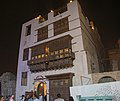Historic Jeddah, known locally as Jeddah Al-Balad, is located in the center of the city of Jeddah. Its history - according to some sources - dates back to pre-Islamic times, and the turning point in its history was during the reign of the Rightly Guided Caliph Othman bin Affan, may God be pleased with him, when he made it a port for Mecca in In the year 26 AH, corresponding to 647 AH, historic Jeddah includes a number of archaeological and heritage monuments and buildings, such as the ruins of the Jeddah Wall and its historical neighborhoods: Al-Mazloum Neighborhood, Al-Sham Neighborhood, Al-Yemen Neighborhood, and Al-Bahr Neighborhood. It also contains a number of historical mosques, the most prominent of which are: Othman bin Affan Mosque, and Al-Shafi’i, Al-Basha Mosque, Akash Mosque, Al-Mimar Mosque, and Al-Hanafi Mosque, in addition to the historical markets.

Jeddah's historical areas
The city of Jeddah was divided within its wall into several neighborhoods, and the ancient citizens of the city called it a neighborhood. These neighborhoods acquired their names according to their geographical location within the city or their fame due to the events that occurred through them, which are:
- The lane of the oppressed\
- Haret Al-Sham
- Yemen lane
- Sea heat
- Karantina neighborhood
- Million Children's Lane

The most famous historical markets in JeddahThe approximate area inside the city wall of Jeddah is 1.5 square kilometers, and it still contains touches of traditional life with an ancient social and economic nature, which is currently concentrated around the mosques and markets of the region, where some old popular and traditional crafts shops are spread, and among the most famous markets of the historical region, past and present, which are Formation of the artery of the region:
- Al Alawi Market
- Bedouin market
- Able market
- Al Nada Market
